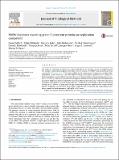FMDV replicons encoding green fluorescent protein are replication competent
Abstract
The study of replication of viruses that require high bio-secure facilities can be accomplished with less stringent containment using non-infectious ‘replicon’ systems. The FMDV replicon system (pT7rep) reported by Mclnerney et al. (2000) was modified by the replacement of sequences encoding chloramphenicol acetyl-transferase (CAT) with those encoding a functional L proteinase (Lpro) linked to a bi-functional fluorescent/antibiotic resistance fusion protein (green fluorescent protein/puromycin resistance, [GFP-PAC]). Cells were transfected with replicon-derived transcript RNA and GFP fluorescence quantified. Replication of transcript RNAs was readily detected by fluorescence, whilst the signal from replication-incompetent forms of the genome was >2-fold lower. Surprisingly, a form of the replicon lacking the Lpro showed a significantly stronger fluorescence signal, but appeared with slightly delayed kinetics. Replication can, therefore, be quantified simply by live-cell imaging and image analyses, providing a rapid and facile alternative to RT-qPCR or CAT assays.
Citation
Tulloch , F A , Pathania , U S , Luke , G A , Nicholson , J , Stonehouse , N J , Rowlands , D J , Jackson , T , Tuthill , T , Hass , J , Lamond , A I & Ryan , M D 2014 , ' FMDV replicons encoding green fluorescent protein are replication competent ' , Journal of Virological Methods , vol. 209 , pp. 35-40 . https://doi.org/10.1016/j.jviromet.2014.08.020
Publication
Journal of Virological Methods
Status
Peer reviewed
ISSN
0166-0934Type
Journal article
Description
The authors gratefully acknowledge the support of the Wellcome Trust (089209/Z/09/Z) and particularly the support providedby Biological and Biotechnological Sciences Research Council (BBSRC) (BB/K003801/1).Collections
Items in the St Andrews Research Repository are protected by copyright, with all rights reserved, unless otherwise indicated.

